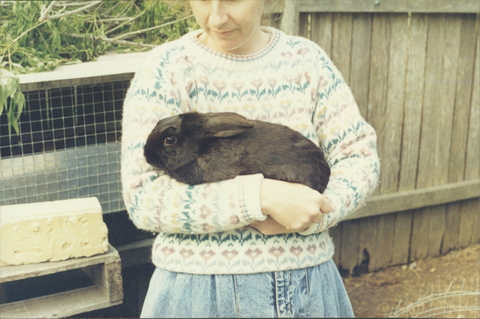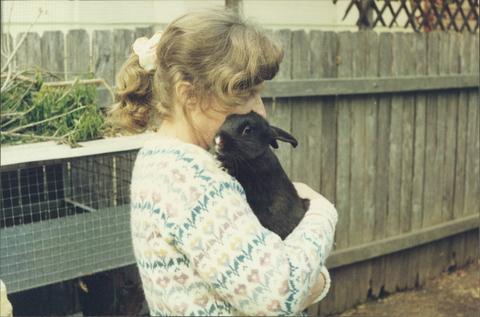The rabbit is a prolific meat producer but they can have disadvantages.
Firstly they have had bad press from the agricultural sector for the damage they have done to rural Australia. Due to this councils can take a dim view of you breeding them, so if you are going to, make sure your setup is absolutely escape proof.

Secondly rabbits are small, cuddly, furry etc. This is good for the rabbits and bad for you. If you had a problem not making the chooks into pets you have no chance with the rabbits. Make sure that the family knows exactly what the rabbits were bought for and that you can kill and dress them as required and that the family will eat them after you have. Otherwise you will only wind up with two more (oops four more no six!) non productive mouths to feed!
BREEDS
Rabbits is rabbits you might say and to a certain extent you would be right. In a survival situation you might attempt to catch wild rabbits and breed from them, they do live in some suburban areas. Myxomatosis could be a problem here, this is a disease introduced deliberately into Australia to control the rabbit plagues of years gone by. If you do have a wild rabbit population close by, be aware that myxomatosis can be spread from it to your domestic rabbits by mosquitoes.
There are however a number of breeds that are kept specifically for meat, these are the New Zealand White, the Californian rabbit, the Old English and the Flemish.
HOUSING
As mentioned before this must be escape proof. Rabbits can put up with low temperatures if they are protected from wind and rain but can suffer in high temperatures so the siting of your hutch should be on the southern side of a house, fence or outbuilding. By siting them in a shady position also, no space is taken from what would otherwise be used to grow fruit or veggies. Full grown rabbits need to be housed separately to ensure reliable breeding and each buck and doe (without a litter) requires 0.5 square metres of floor space. Thus a hutch 1 metre long by 50 to 75cm deep by 45 to 60cm high for each rabbit will provide plenty of space. The hutch would generally be composed of a strong wooden weather proof sleeping area as one half , filled with suitable bedding eg straw, shredded paper or hay. The other half being wire mesh over a wooden or steel frame. The hutch could be movable and placed on the ground to give the rabbit’s access to grass or fixed as mentioned earlier.
To produce meat regularly in a back yard set up one buck (male) and four to five does (females) are required so you will need 5 to 6 hutches. These should be arranged in the same area to facilitate management of the rabbits. If space is limited and you intend to keep chickens also the rabbit hutches could be suspended over the chicken run. This would localise all livestock to the one area with the subsequent saving of time and space. The chickens would also have access to the rabbits droppings so they would eat any insect eggs or larvae and scavenge any feed falling from the hutch onto the ground.
FEEDING AND WATERING
There are commercial pellets available for rabbits but it is better to get used to feeding the rabbits on home grown or foraged materials. An emergency stock of a bag or two of pellets would be a good idea just in case foraging became temporarily impractical.
Rabbits will eat most green fodder including weeds and grass clippings, fruit and veggie peelings, cooked veggies, excess produce from the vegetable patch. etc they will also eat sprouted grains (high in vitamins) and lucerne hay. Palatability is of concern to the rabbit as they will not consume enough food to produce meat efficiently if it is not palatable. With this in mind introduce new foods a bit at a time. They also dislike dusty or gritty foods so especially foraged greens should be washed before being given to the rabbits.

Water requirements for rabbits are similar to chickens in that fresh water needs to accessible at all times. The waterers described in the article on chickens would suffice. Adult rabbits consume 280mls of water per day but a suckling doe can consume up to 600mls per day.
BREEDING
The does of small breeds are ready for mating at approximately 5 ½ months, larger breeds one month older. The doe should always be taken to the buck and never the reverse. The bucks hutch should have a wooden floor covered with absorbent litter, this enhances comfort for doe and buck and increases the likelihood of a successful mating. The buck and doe should be left together for 10 minutes then the doe returned to her hutch.
During pregnancy the doe should be kept as quiet and secluded as possible otherwise she may abort. A nesting box should be made available on the 28th day filled with straw, grass or any soft non-stringy material. The entrance should have a raised lip so the baby rabbits are brushed off when the mother exits, and are not dragged out on the wire area. The mother should be left alone as much as possible after the birth. The young rabbits are weaned at 6 weeks and can be taken away from the mother at this stage.
PRODUCTS
MEAT - Young rabbits are ready to be slaughtered when they weigh 2 to 2.5kg live weight, approximately half of this or 1 to 1.25kg is edible meat. A doe will have 3 to 4 litters per year and average 8 young per litter so assuming a 5 doe 1 buck system this will provide about 3.5kg of meat per week.
SKINS - The rabbit skin once tanned (see tanning for methods) can be sewn together to make clothing or moccasins, gloves etc.
CARBON DIOXIDE - Strange as it may seem rabbits breathe and in doing so they produce up to 40grams of carbon dioxide per day. So what you might say? But studies in the United States suggest that increasing the carbon dioxide content of the air in a greenhouse will increase production of plants in the greenhouse. So if you have or plan to build a backyard green house so you can produce more winter veggies you might consider setting aside some space to grow your rabbits in it as well.
MANURE -Manure can be used in a number of ways -
1/ It can be gathered directly and spread onto the garden as is.
2/ It can be composted first by gathering and addition to a compost pile.
3/ It can be composted in situ by having trays underneath the hutches containing hay, straw, sawdust, compost or other absorbent material. The manure and urine is then trapped and composted where it falls. This method also results in less smell.
4/ It can be combined with the chicken system as mentioned earlier.
KILLING AND SKINNING
There are two methods of killing which are not as thoroughly disgusting as decapitation. The first is similar to dispatching a chook by dislocating the neck. Grasp both hind feet with the left hand and wrap you right around the animals neck just below its ears. Holding the animal diagonally across your thighs stretch it out then raise the rabbit’s neck with a quick jerk to dislocate the head.
The second uses a slug gun. Place the end of the barrel at the back of the head between the ears aiming as if to bore a hole through to the tip ofthe nose, a quick pull of the trigger and bunny is ready to skin and gut.
To skin a very sharp knife is required. First make a cut down the inside of one hind leg to the crutch, then cut around the leg. Do the same on the other leg, cut around the crutch leaving a piece of for around the genitals. Work the skin up to the tail bone and cut through it. Slowly work the skin up the body keeping it in one piece. When there is enough to grip the rear feet can be held steady by placing your foot on them and the pelt pulled up the body. Cut through the foreleg at the hock so that the skin is freed up to the head. The rabbit may now be decapitated and the skin removed entirely. The skin, now inside out, should be drawn over a wire loop to dry.
To gut the rabbit slit along the middle of the carcass to the throat taking care not to puncture the bladder. Pull the entrails out and compost or feed to the chickens. The carcass is now ready to be jointed.



